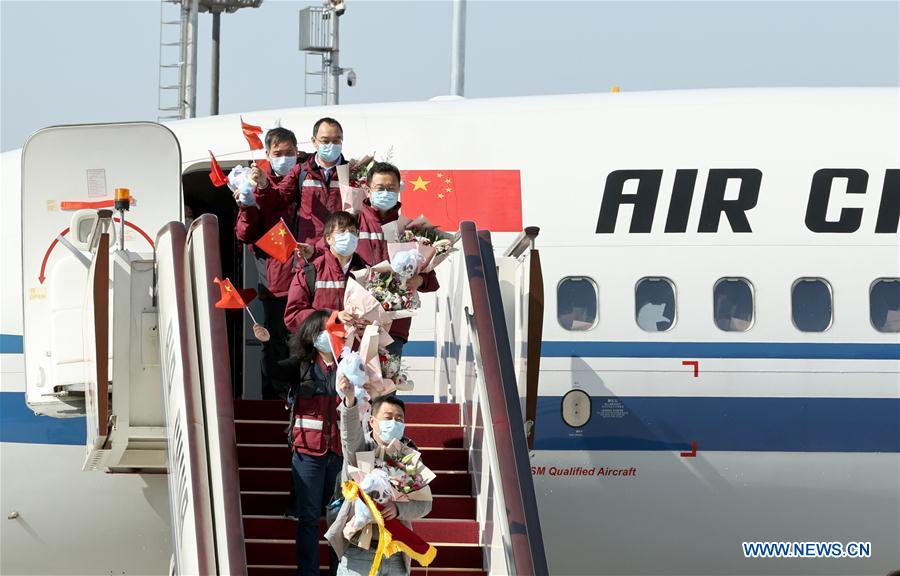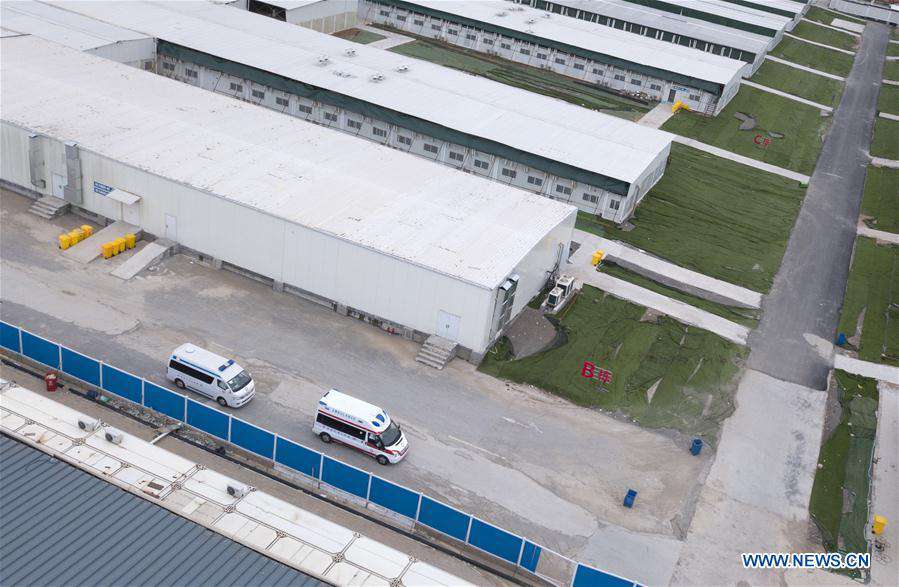

By the end of April 26, central China’s Hubei province, which had been the main battlefield in the fight against the novel coronavirus disease (COVID-19) in China, had brought its number of confirmed COVID-19 cases down to zero.

Members of medical assistance team from Chinese Center for Disease Control and Prevention (CDC) supporting virus-hit Hubei Province get off the airplane at Beijing Capital International Airport in Beijing, capital of China, April 20, 2020. (Xinhua/Chen Jianli)
After being the worst-hit Chinese province in the pandemic, Hubei had cured a total of 63,616 COVID-19 patients as of the end of April 26.
While China makes significant progress in fighting the pandemic, the number of COVID-19 cases around the world continues to mount.
According to data released by the World Health Organization (WHO), the number of confirmed COVID-19 cases outside China had topped 2.9 million as of 9 a.m. April 29 Beijing time, with the U.S. alone reporting more than 1 million confirmed cases.
A simple comparison of data and facts inside and outside China can demonstrate that the country has made remarkable achievements in fighting the pandemic both in terms of medical treatment and epidemic prevention and control.
However, China’s results have led to politicians and media outlets of certain Western countries to make groundless accusations against it, cooking up all kinds of stories and arguments to attack and smear China out of ulterior motives.
Some have claimed that the real number of confirmed COVID-19 cases in China could be “15 to 40 times” higher than the data officially released by the country.
The people who made such claims have seen the statistics released by China but ignored the great efforts made and the solidarity shown by the 1.4 billion people across the country over the past more than two months, said Ding Gangqiang, head of the epidemiological survey team stationed in the Chinese city of Wuhan, capital of Hubei and previous epicenter of the COVID-19 outbreak.
In fact, the epidemiological survey team from the Chinese Center for Disease Control and Prevention, which Ding led, has done meticulous and solid work regarding COVID-19 in Wuhan.
In order to guarantee complete success in curbing the spread of the virus, the team has adopted a “5+1” work pattern to ensure proper management, investigation, and follow-up visits to close contacts of confirmed cases and strict epidemic prevention and control measures through collaboration between personnel from five groups - grid-based community workers, health service center doctors, officials dispatched to grass-roots levels, public security officers and volunteers.
According to official statistics, the cumulative cure rate of COVID-19 in Wuhan is 92.2 percent, while the proportion of cured severe cases in the city is 88.9 percent.
Such heartening results in fighting the pandemic in China could not have been achieved without the appropriate macro policies and epidemic prevention and control strategies, contributions of medical workers, as well as nationwide efforts people all over the country.
The secrets to China’s success in controlling COVID-19 can be summarized as follows:
1. First-level public health emergency response activated across the country
Between Jan. 23 and 25, many provinces, autonomous regions, and municipalities in China activated the first-level public health emergency response to the COVID-19 outbreak, which ensured the prompt and orderly implementation of epidemic prevention and control measures.
Out of all the efforts and measures put in place to prevent and control the pandemic, the most important had to be the universal consensus on united actions nationwide to fight the disease, said Ding.
“Under the strong leadership of the central government, people across the country quickly formed a consensus on the disease and were mobilized to fight the epidemic in solidarity. This is the most critical premise of China’s success in overcoming a major disaster and epidemic,” Ding stressed.
2. Locking down Wuhan
After COVID-19 cases started to surge in Hubei province, China put Wuhan under lockdown and imposed outbound travel restrictions on the whole of Hubei province, effectively cutting off the virus transmission route.
“China’s resolute lockdown of Wuhan, a megacity with more than 10 million people, showed the great importance the country attached to the prevention and control of the disease and its resolve in fighting the epidemic,” said Tan Xiaodong, professor and doctoral supervisor at the School of Health Sciences of Wuhan University.
“The lockdown in Wuhan and measures including traffic restrictions and closed-off management of communities across the city were critical in curbing the spread of the epidemic,” Tan noted.
3. Building makeshift and temporary hospitals to treat COVID-19 patients

Aerial photo taken on April 14, 2020 shows ambulances transferring the last batch of COVID-19 patients to other hospitals at Leishenshan (Thunder God Mountain) Hospital in Wuhan, central China's Hubei Province. (Xinhua/Cheng Min)
The Huoshenshan Hospital and Leishenshan Hospital, two makeshift hospitals China quickly built to treat COVID-19 patients in Wuhan after the outbreak of the disease, in addition to several Fangcang temporary hospitals converted from public venues in the city, did much to ease the pressure on medical resources during the initial stage of the pandemic.
These newly built medical facilities helped realize the country’s goal of leaving no one unattended to and effectively curbed the spread of the virus.
4. Tens of thousands of medical workers from all over the country went to help Hubei

A medical team member waves goodbye to his friends and relatives before leaving for Hubei at Taiyuan Wusu International Airport in north China's Shanxi Province, Feb. 18, 2020. (Xinhua/Zhan Yan)
As Hubei and its capital Wuhan faced its most difficult period, medical workers volunteered to join assistance teams and went from provinces and cities around the country to help Hubei fight the virus.
Meanwhile, each city in Hubei province was paired up with a province from around the country to provide targeted assistance.
The best doctors and equipment were assembled in Hubei, and medical resources across the country were mobilized to aid the province in its fight against the COVID-19.
A total of 42,000 medical workers from across the country, including top medical experts and specialists in respiratory medicine, infectious diseases, and critical care medicine and more than 10 academicians, together with over 60,000 local medical staff, provided an extremely high standard of medical care for COVID-19 patients in Wuhan.
5. “Four early” + free medical care
While promoting a set of guidelines on early detection, early quarantine, early diagnosis and early treatment to control the epidemic, China provided free medical care for confirmed COVID-19 patients, which helped reduce the economic burden on patients and effectively contained the spread of the disease.
6. Important role of traditional Chinese medicine
Traditional Chinese medicine (TCM) also helped fight the virus by bringing its unique advantages into play.
Combinations of TCM and Western medicine were actively adopted in medical facilities across the country. Over 90 percent of all confirmed COVID-19 cases on the Chinese mainland saw their symptoms alleviated after receiving TCM treatment.
7. Face masks on everyone
The National Health Commission (NHC) suggested early on Jan. 29 that people wear face masks in public places.
Chinese people followed the advice and were cooperative in the nationwide efforts to combat the disease, said Tan, stressing that everyone in the country made contributions to the achievements in the battle.
8. Joint prevention and control mechanism
The joint prevention and control mechanism which was implemented across the country at grassroots levels played an important role in China’s battle against the virus.
Under the mechanism, prevention and control measures were launched to control the sources of infection, interrupt transmission of the virus and protect the public, especially the population susceptible to infection.
Thanks to the mechanism, many volunteers contributed to guaranteeing effective quarantine in villages and communities, and people around the country donated money and supplies to support the united efforts to fight the disease.
The mechanism also helped ensure that people in quarantine had sufficient living materials despite the strict measures being taken across the country.
9. Sharing experience, ensuring transparency of data
China has been reporting its numbers of confirmed and suspected COVID-19 cases across the country in real time every day to ensure openness and transparency of the relevant information.

Chinese medical and technical experts share their experience with their Venezuelan counterparts in Caracas, Venezuela, April 1, 2020. Chinese and Venezuelan experts gathered in Caracas on Wednesday to assess diagnostic procedures to bolster Venezuela's capacity to tackle the COVID-19 epidemic. (Miraflores/Handout via Xinhua)
At the same time, the country has ensured the timely sharing of its medical experience in fighting COVID-19, constantly improved its diagnosis and treatment schemes, and drawn up clear procedures for diagnosis and treatment, effective medicines, and rescue measures for severe patients in the shortest time possible.
10. Saving lives as the top priority
The most important piece of advice China can offer to the world in the fight against the COVID-19 pandemic is to spare no effort to save lives, prevent and control the spread of the virus at all costs, and give top priority to the safety and health of the people.
People’s lives and health have always been the top priority in China, a fact that was vividly proven in the worst-hit Chinese city of Wuhan during the pandemic, according to Ding.
In the face of the pandemic, saving lives became a more urgent task than any other. The country was more than willing to sacrifice economic development for a period of time in order to save lives, Ding noted.
The three principles - controlling the source of infection, interrupting transmission of the virus and protecting the susceptible population from infection - should always be followed in efforts to control an infectious disease, Ding said.
Tan said Wuhan’s experience in fighting COVID-19 features the main role played by the government, joint efforts of society, obedience of individuals, and contributions of families.
What is needed most right now is close cooperation between countries, Ding said, noting that countries can overcome their own weaknesses by learning from each other’s strong points.
Efforts to fight the pandemic must follow scientific methods, Ding said, stressing that although there are differences in countries’ national conditions, systems and cultures, scientific epidemic prevention and control measures are universally adaptable around the world.

 Award-winning photos show poverty reduction achievements in NE China's Jilin province
Award-winning photos show poverty reduction achievements in NE China's Jilin province People dance to greet advent of New Year in Ameiqituo Town, Guizhou
People dance to greet advent of New Year in Ameiqituo Town, Guizhou Fire brigade in Shanghai holds group wedding
Fire brigade in Shanghai holds group wedding Tourists enjoy ice sculptures in Datan Town, north China
Tourists enjoy ice sculptures in Datan Town, north China Sunset scenery of Dayan Pagoda in Xi'an
Sunset scenery of Dayan Pagoda in Xi'an Tourists have fun at scenic spot in Nanlong Town, NW China
Tourists have fun at scenic spot in Nanlong Town, NW China Harbin attracts tourists by making best use of ice in winter
Harbin attracts tourists by making best use of ice in winter In pics: FIS Alpine Ski Women's World Cup Slalom
In pics: FIS Alpine Ski Women's World Cup Slalom Black-necked cranes rest at reservoir in Lhunzhub County, Lhasa
Black-necked cranes rest at reservoir in Lhunzhub County, Lhasa China's FAST telescope will be available to foreign scientists in April
China's FAST telescope will be available to foreign scientists in April